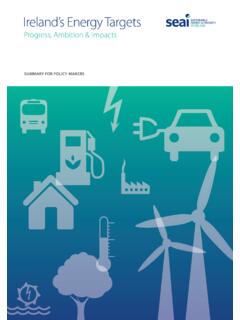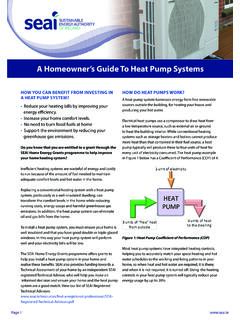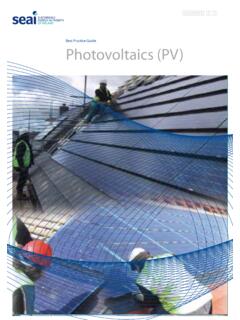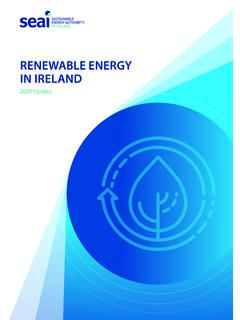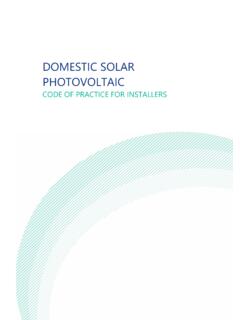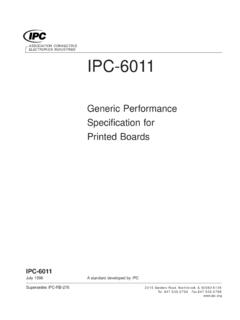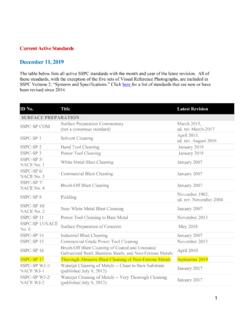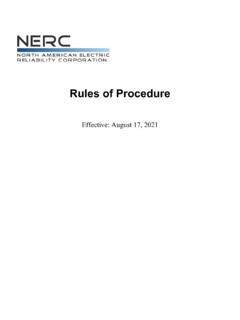Transcription of Domestic Energy Assessment Procedure (DEAP)
1 Domestic Energy Assessment Procedure (DEAP) Version Ireland s official method for calculating and rating the Energy performance of dwellingsJuly 2020 DEAP Manual Version This document describes DEAP, Version , dated July 2020. This version is applicable to Building Energy Ratings being published for new and existing dwellings. Building designers, Energy rating Assessors and other users should ensure that they are using the latest version of this document and accompanying software. Updates will be published on the SEAI website . Published by: The Sustainable Energy Authority of Ireland, 3 Park Place, Hatch Street Upper, Dublin 2, D02 FX65 Sustainable Energy Authority of Ireland SEAI is Ireland s national Energy authority investing in, and delivering, appropriate, effective and sustainable solutions to help Ireland s transition to a clean Energy future.
2 We work with the public, businesses, communities and the Government to achieve this, through expertise, funding, educational programmes, policy advice, research and the development of new technologies. SEAI is funded by the Government of Ireland through the Department of Communications, Climate Action and Environment. Contacts: t: 1890 734237 e: w: Sustainable Energy Authority of Ireland Reproduction of the contents is permissible provided the source is acknowledged DEAP Manual Version 2 Contents Change Log 4 Summary 5 Introduction 7 Scope of the Dwelling Energy Assessment Procedure (DEAP) 8 General Principles 10 Calculation procedures and Conventions 15 1 Dwelling dimensions 18 2 Ventilation rate 25 Chimneys and flues 26 Intermittent Fans and passive vents 27 Air leakage pressurisation test 27 Draught lobby 28 Sheltered Sides 29 Mechanical ventilation 30 3 Heat losses 33 U-values of opaque elements 34 Window U-values 35 U-values of elements adjacent to an unheated space 37 Thermal bridging 41 Dwellings that are part of larger premises 41 Curtain Walling 41 Including glass block walls in DEAP 42 Perspex or plastic roofs 42 4 Domestic hot water 43 Hot Water Distribution Losses 44 Hot Water Storage Losses 44 Primary Circuit Losses 45 Solar Water Heating 45 Group/ Community Heating and District Heating Schemes 45 Hot Water Backup 46 5 Lighting
3 And internal heat gains 47 6 Solar heat gains 48 Solar gains for glazed openings 48 Openings for which solar gain is included 49 More than one glazing type 49 7 Mean internal temperature and dwelling thermal mass 50 Heating schedule 50 Living area fraction 50 Internal heat capacity 50 Mean internal temperature with ideal heating system 51 8 Space heat use 52 9 Space heating requirements 53 Heating systems 53 Heating system efficiency 54 Heating controls 57 10 Total Energy use 61 Energy use 61 DEAP Manual Version 3 Fuel factors 61 Main heating system fuel types 61 Secondary heating system fuel types 64 Water heating fuel types 64 Electricity for pumps and fans 64 Electricity for lighting 65 Group /Community Heating and District Heating schemes 65 Renewable and Energy saving technologies 66 11 Energy , emissions and costs 67 12 Building Energy rating 68 13 Building regulations 69 Building Regulations 2005 TGD L conformance demonstration 69 Building Regulations 2008, 2011 and 2019 TGD L conformance demonstration 69 References 71 List of relevant standards 72 Appendix A: Primary and secondary heating systems 75 Appendix B: Gas and oil boiler systems, boilers with a thermal store, and range cooker boilers 79 Appendix C: Group (Community) heating/ District heating schemes 83 Appendix D: Method of determining gross seasonal efficiency values for gas and oil boilers 88 Appendix E: Gross seasonal efficiency for gas, oil or solid fuel room heaters 97 Appendix F: Electric CPSUs 99 Appendix G: Heat pumps 100 Appendix H: Solar water heating 118 Appendix I.
4 Water Efficiency Calculation Methodology 124 Appendix J: Gross seasonal efficiency for solid fuel boilers from test data 127 Appendix K: Thermal bridging 129 Appendix L: Energy for lighting 129 Appendix M: Photovoltaic (PV) technology and on site wind turbines 135 Appendix N: Micro-cogeneration (also known as micro-CHP) 139 Appendix P: Assessment of internal temperature in summer 141 Appendix Q: Special features and specific data 147 Appendix S: DEAP for existing dwellings: survey methodology and default data 148 Appendix U: Submission of BER assessments 176 TABLES 178 Acknowledgements: DEAP is the outcome of a development study completed for SEAI by a project team from the UCD Energy Research Group, National Energy Services Ltd., Rickaby Thompson Associates Ltd. and Emerald Energy .
5 Much of the calculation Procedure in DEAP, the accompanying tabulated data and the documentation in this manual is drawn or adapted from the UK Standard Assessment Procedure (SAP) for Energy Rating of Dwellings. DEAP Manual Version 4 Change Log Section Change Summary Additional text relating to the National Calculation Methodology. General Principles New text on air pressure tests. - Window U-values Additional guidance on certified non-default data for windows. New guidance on standard window and door sizes for testing. - U-values of elements adjacent to an unheated space Additional text on the Ru value for a crawl space in a room-in-roof scenario. - Dwellings that are part of larger premises Additional text in note (c). Curtain Walling Additional guidance on requirements for performance data for curtain walling systems.
6 4 Domestic Hot Water Additional text on bath where a shower head is fitted to the taps. HW Storage Losses Additional text on the use of data from labels/name-plates. - Group/ Community Heating and District Heating Schemes In Note (d), the default loss factor is now given in kWh/day, which can now be used directly in DEAP. Appendix G Change to footnote 2 in section G1. New table of default flow temperatures. - Double-duct heat pumps and heat recovery systems incorporating heat pump functionality Significant changes to the guidance on these systems. Appendix K Additional guidance on the relevant person to sign-off thermal bridging documentation. Additional text on certification of non-ACD Psi-values. Appendix L Obsolete text removed. Appendix S U-values of Walls Additional guidance on the use of Table S3.
7 Additional guidance on walls adjoining partially-heated premises. New guidance on plasterboard in houses constructed before 1950. Appendix U Updated to take account of DEAP 4. Further information added on warnings and errors Table 2a New data added to table for 375mm x 900mm cylinder. Table 4f In Note (f), the reference to Table 3b and 3c has been removed. In Note on use of non-default central heating pump electricity consumption: , the technical data sheet is now an acceptable source of EEI data, Table 11a New data added to table for Party Floors . Table 12a Correction to spelling of Mud Phuska . DEAP Manual Version 5 Summary The Dwelling Energy Assessment Procedure (DEAP) is the Irish official Procedure for calculating and assessing the Energy required for space heating, ventilation, water heating and lighting, less savings from Energy generation technologies.
8 DEAP calculates the annual delivered Energy consumption, primary Energy consumption and carbon dioxide emissions for standardised occupancy. The DEAP software contains equations or algorithms representing the relationships between the factors contributing to the annual Energy performance of the dwelling. The software is accompanied by a series of reference data tables. The DEAP calculation is also available as a Microsoft Excel workbook on 1. DEAP is compliant with the methodology framework in the EU Energy Performance of Buildings Directive (EPBD). The DEAP calculation framework is based on IS EN 13790 and draws heavily on the calculation procedures and tabulated data of the Standard Assessment Procedure (SAP) for Energy rating of dwellings in the UK.
9 Annex I of the of the Energy Performance of Buildings Directive 2010/31/EU (EPBD) as amended by Directive 2018/844/EU (EPBD) outlines requirements for determining Energy Performance of Buildings and methodologies. In Ireland, the national calculation methodology required by the EPBD is described in the annexes of the overarching standards namely EN ISO 52000-1:2017, EN ISO 52003-1:2017, EN ISO 52010-1:2017, EN ISO 52016-1:2017, and EN ISO 52018-1:2017 and are available from NSAI (National Standards Authority of Ireland). As outlined in the standards, the completed annexes are available here. The DEAP methodology and software is used to demonstrate compliance with the EPBD (recast) in Ireland including elements of the Irish Building Regulations Part L 2005, 2008, 2011 and 2019 for new dwellings and for generating Building Energy Rating (BER) labels and BER Advisory Reports.
10 This provision applies to new dwellings and dwellings for sale or rent. of 2012 details the Irish legislative requirements for BER, including scenarios where a Building Energy rating is required and scenarios where buildings are exempted. For Building Regulations 2005 Technical Guidance Document (TGD) L, the DEAP software calculates the Carbon Dioxide Emission Rate (CDER) of the dwelling, and the corresponding Maximum Permitted Carbon Dioxide Emission Rate (MPCDER), expressed in units of kg CO2 per square metre per annum. This provision applies to new dwellings built between 1st July 2006 and 1st July 2008 subject to transitional arrangements cited in Building Regulations 2005 TGD L. DEAP compares the dwelling s Energy Performance Coefficient (EPC) and Carbon Performance Coefficient (CPC) to the Maximum Permitted Energy Performance Coefficient (MPEPC) and Maximum Permitted Carbon Performance Coefficient (MPCPC) for Building Regulations 2008, 2011 and 2019 TGD L.


